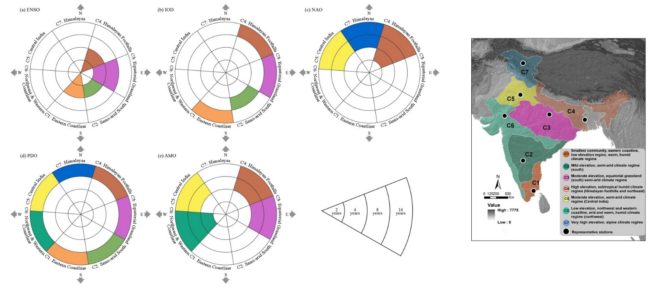
Today’s we launch one of our promised activities: the NPG Paper of the Month.
This month the award is achieved by Jürgen Kurths and co-authors for their paper “Unravelling the spatial diversity of Indian precipitation teleconnections via a non-linear multi-scale approach” (https://www.nonlin-processes-geophys.net/26/251/2019/).
Ankit Agarwal, one of the authors of the manuscript, tells us about the importance of the results achieved with this paper where the authors gained insights on spatial diversity of Indian precipitation teleconnections by studying the effects of global climate indices on Indian precipitation patterns at varying timescales.
Ankit is a hydro-climatologist at the Potsdam Institute for Climate Impact Research and Helmholtz Center for Geosciences, section 5.4 (Hydrology). He is interested in interdisciplinary research to understand multi-scale interactions among different components of Earth. He develops new methods and apply them in hydrology and climatology for advance understanding. His next position is due as an assistant professor at the Department of Hydrology, Indian Institute of Technology-Roorkee, India.
Atmospheric and oceanic phenomena are characterized by multi-scale behavior and their influence on precipitation varies across multiple timescales. Understanding the spatiotemporal variability of coupling between various global climate indices and precipitation is of great importance for accurate prediction of climatic variations on different time-scales. While this coupling has been investigated before, it has been a challenge to address its non-linear, scale-varying, and spatially diverse behavior. The study by Kurths et al., 2019 proposes a novel, and general, framework to disentangle the non-linear dependency structure between rainfall and climate patterns across space and temporal scales, by introducing the concept of multiscale event synchronization (Agarwal et al., 2017).
More specifically, the study examines the spatial diversity of Indian precipitation teleconnection at different time scales, first by identifying homogenous communities (Agarwal et al., 2018) and later by computing nonlinear linkages between the identified communities (spatial regions) and dominant climatic patterns, represented by climatic indices such as El-Nino Southern Oscillation (ENSO), Indian Ocean Dipole (IOD), North Atlantic Oscillation (NAO), Pacific Decadal Oscillation (PDO) and Atlantic multi-decadal Oscillation (AMO). The results of the study unravel the spatial variation of the climate indices across India and across time scales. In particular, ENSO and the (IOD) exhibit precipitation teleconnections in the peninsular and southeast areas of India on interannual and decadal scales, respectively, whereas the North Atlantic Oscillation (NAO) has a strong connection to precipitation particularly in the northern regions (refer to the figure). The effect of PDO is seen across the entire country, while precipitation variations over the semi-arid and arid regions of Central India have linkages to the AMO. The proposed method provides a powerful approach for capturing the dynamics of influences of climatic indices on Indian precipitation and, hence, helps improving precipitation forecasting.
A comparison of the results with the state-of-the-art method, wavelet coherence, shows that the proposed method has much higher skill in detecting linkages between the Indian monsoon system and climate patterns. The authors believe that the findings presented in the paper will appeal to the broader society of Earth scientists and modelers given the problems they face in understanding the dynamics and forecasting Indian precipitation.
References
Kurths, J., Agarwal, A., Shukla, R., Marwan, N., Rathinasamy, M., Caesar, L., Krishnan, R., and Merz, B.: Unravelling the spatial diversity of Indian precipitation teleconnections via a non-linear multi-scale approach, Nonlin. Processes Geophys., 26, 251-266, https://doi.org/10.5194/npg-26-251-2019, 2019.
Agarwal, A., Marwan, N., Maheswaran, R., Merz, B., Kurths, J.: Quantifying the roles of single stations within homogeneous regions using complex network analysis, Journal of Hydrology, 563, 802-810, https://doi.org/10.1016/j.jhydrol.2018.06.050, 2018.
Agarwal, A., Marwan, N., Rathinasamy, M., Merz, B., Kurths, J.: Multi-scale event synchronization analysis for unravelling climate processes: a wavelet-based approach, Nonlin. Processes Geophys., 24, 599-611, https://doi.org/10.5194/npg-24-599-2017, 2017.
